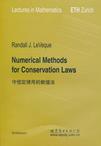守恒定律用的数值法
2010-9
世界图书出版公司
勒维克
214
无
these notes developed from a course on the numerical solution of conservation laws first taught at the university of washington in the fall of 1988 and then at eth during the following spring. the overall emphasis is on studying the mathematical tools that are essential in developing, analyzing, and successfully using numerical methods for nonlinear systems of conservation laws, particularly for problems involving shock waves. a reasonable understanding of the mathematical structure of these equations and their solutions is first required, and part i of these notes deals with this theory. part ii deals more directly with numerical methods, again with the emphasis on general tools that are of broad use. i have stressed the underlying ideas used in various classes of methods rather than presenting the most sophisticated methods in great detail. my aim was to provide a sufficient background that students could then approach the current research literature with the necessary tools and understanding.
ⅰ mathematical theory 1 introduction 1.1 conservation laws 1.2 applications 1.3 mathematical difficulties 1.4 numerical difficulties 1.5 some references 2 the derivation of conservation laws 2.1 integral and differential forms 2.2 scalar equations 2.3 diffusion 3 scalar conservation laws 3.1 the linear advection equation 3.2 burgers' equation 3.3 shock formation 3.4 weak solutions 3.5 the riemann problem 3.6 shock speed 3.7 manipulating conservation laws 3.8 entropy conditions 4 some scalar examples 4.1 traffic flow 4.2 two phase flow 5 some nonlinear systems 5.1 the euler equations 5.2 isentropic flow 5.3 isothermal flow 5.4 the shallow water equations 6 linear hyperbolic systems 6.1 characteristic variables 6.2 simple waves 6.3 the wave equation 6.4 linearization of nonlinear systems 6.5 the riemann problem 7 shocks and the hugoniot locus 7.1 the hugoniot locus 7.2 solution of the riemann problem 7.3 genuine nonlinearity 7.4 the lax entropy condition 7.5 linear degeneracy 7.6 the riemann problem 8 rarefaction waves and integral curves 8.1 integral curves 8.2 rarefaction waves 8.3 general solution of the riemann problem 8.4 shock collisions 9 the pdemann problem for the euler equations 9.1 contact discontinuities 9.2 solution to the riemann problem ⅱ numerical methods bibliography
Discontinuous solutions of the type shown above clearly do not satisfy the PDE in theclassical sense at all points, since the derivatives are not defined at discontinuities. Weneed to define what we mean by a solution to the conservation law in this case. To findthe correct approach we must first understand the derivation of conservation laws fromphysical principles. We wilI see in Chapter 2 that this leads first to an integral form of theconservation law, and that the differential equation is derived from this only by imposingadditional smoothness assumptions on the solution. The crucial fact is that the integralform continues to be valid even for discontinuous solutions. Unfortunately the integral form is more difficult to work with than the differentialequation, especially when it comes to discretization. Since the PDE continues to holdexcept at discontinuities, another approach is to supplement the differential equations byadditional“jump conditions”that must be satisfied across discontinuities. These can bederived by again appealing to the integral form. To avoid the necessity of explicitly imposing these conditions, we will also introducethe weak form of the differential equations. This again involves integrals and allowsdiscontinuous solutions but is easier to work with than the original integral form of theconservation laws. The weak form will be fundamental in the development and analysisof numerical methods. Another mathematical difficulty that we must face is the possible nonuniqueness ofsolutions. Often there is more than one weak solution to the conservation law with thesame initial data. If our conservation law is to model the real world then clearly onlyone of these is physically relevant. The fact that the equations have other, spurious,solutions is a result of the fact that our equations are only a model of reality and somephysical effects have been ignored. In particular, hyperbolic conservation laws do notinclude diffusive or viscous effects. Recall, for example, that the Euler equations resultfrom the Navier-Stokes equations by ignoring fluid viscosity. Although viscous effectsmay be negligible throughout most of the flow, near discontinuities the effect is alwaysstrong. In fact, the full Navier-Stokes equations have smooth solutions for the simpleflows we are considering, and the apparent discontinuities are in reality thin regions withvery steep gradients. What we hope to model with the Euler equations is the limit ofthis smooth solution as the viscosity parameter approaches zero, which will in fact be oneweak solution of the Euler equations.

无
文字流畅易懂,前半部分对双曲守恒方程(组)解的性质进行了介绍,特别着重于黎曼问题的两类典型解:激波和稀疏波。后半部分对双曲方程的基本数值解法进行介绍。讨论不算深入,但对基本问题的讲解比较全面,适合于入门。
不收藏就亏大发了,建议火速购买
书写的很好,很有用